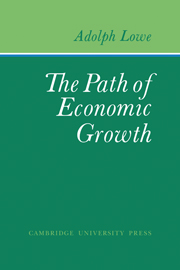Book contents
- Frontmatter
- Contents
- Preface
- Acknowledgments
- PART I The Basic Model
- PART II Changes in the Rate of Change
- PART III Changes in the Rate of Change
- PART IV Changes in the Rate of Change
- 21 The Scope of the Investigation
- 22 Dynamic Equilibrium Once More
- 23 Nonneutral Innovations: A General Survey
- 24 Pure Labor-Displacing Innovations
- 25 Pure Capital-Displacing Innovations
- 26 Some Comments on Combined Changes in the Input of Labor and Capital
- 27 Technical Progress and Diminishing Returns
- 28 Some Concluding Remarks
- Appendix: An Alternative Presentation of Lowe's Basic Model
- Glossary of Recurring Symbols
- Name Index
- Subject Index
25 - Pure Capital-Displacing Innovations
Published online by Cambridge University Press: 07 October 2011
- Frontmatter
- Contents
- Preface
- Acknowledgments
- PART I The Basic Model
- PART II Changes in the Rate of Change
- PART III Changes in the Rate of Change
- PART IV Changes in the Rate of Change
- 21 The Scope of the Investigation
- 22 Dynamic Equilibrium Once More
- 23 Nonneutral Innovations: A General Survey
- 24 Pure Labor-Displacing Innovations
- 25 Pure Capital-Displacing Innovations
- 26 Some Comments on Combined Changes in the Input of Labor and Capital
- 27 Technical Progress and Diminishing Returns
- 28 Some Concluding Remarks
- Appendix: An Alternative Presentation of Lowe's Basic Model
- Glossary of Recurring Symbols
- Name Index
- Subject Index
Summary
Superficially considered, pure capital-displacing innovations appear as the reverse of pure labor-displacing innovations. Closer inspection, however, reveals fundamental differences. They begin with the standard of measurement applicable to displaced capital as compared with displaced labor. As we saw, the latter lends itself to the standard of homogeneous wage units that measure physically homogeneous labor units. On the other hand, it is difficult to imagine empirical cases in which capital-displacing innovations displace part of a homogeneous set of machines, while the remaining machines continue to operate in physically unchanged form. The normal case is a replacement of the original type of machinery in use by a new type, representing a smaller number of wage units, yet being capable of producing, with the original labor input, the same output as initially but at lower unit costs. In other words, a process of “capital transmutation” must precede the actual introduction of a typical capital-displacing innovatïon.
Fortunately, one major obstacle, which stands in the way of speedy transmutation when a stream of neutral innovation is to be absorbed, namely, the need to transmute the entire stock in one period of production, is absent in the present case. Current amortization of the original capital stock provides the funds with the help of which the original stock can be gradually transmuted into the new one. This is at least so if the innovation occurs in the consumer-good sector. Investible funds of the same origin are available also when the innovation occurs in one of the equipment-good sectors.
- Type
- Chapter
- Information
- The Path of Economic Growth , pp. 266 - 271Publisher: Cambridge University PressPrint publication year: 1976



